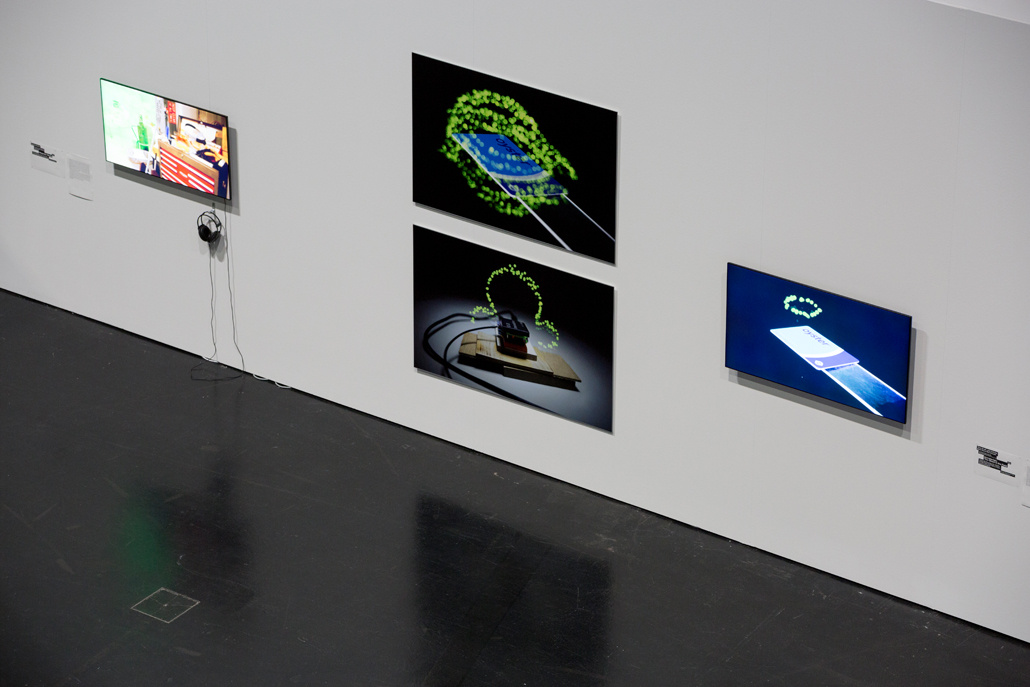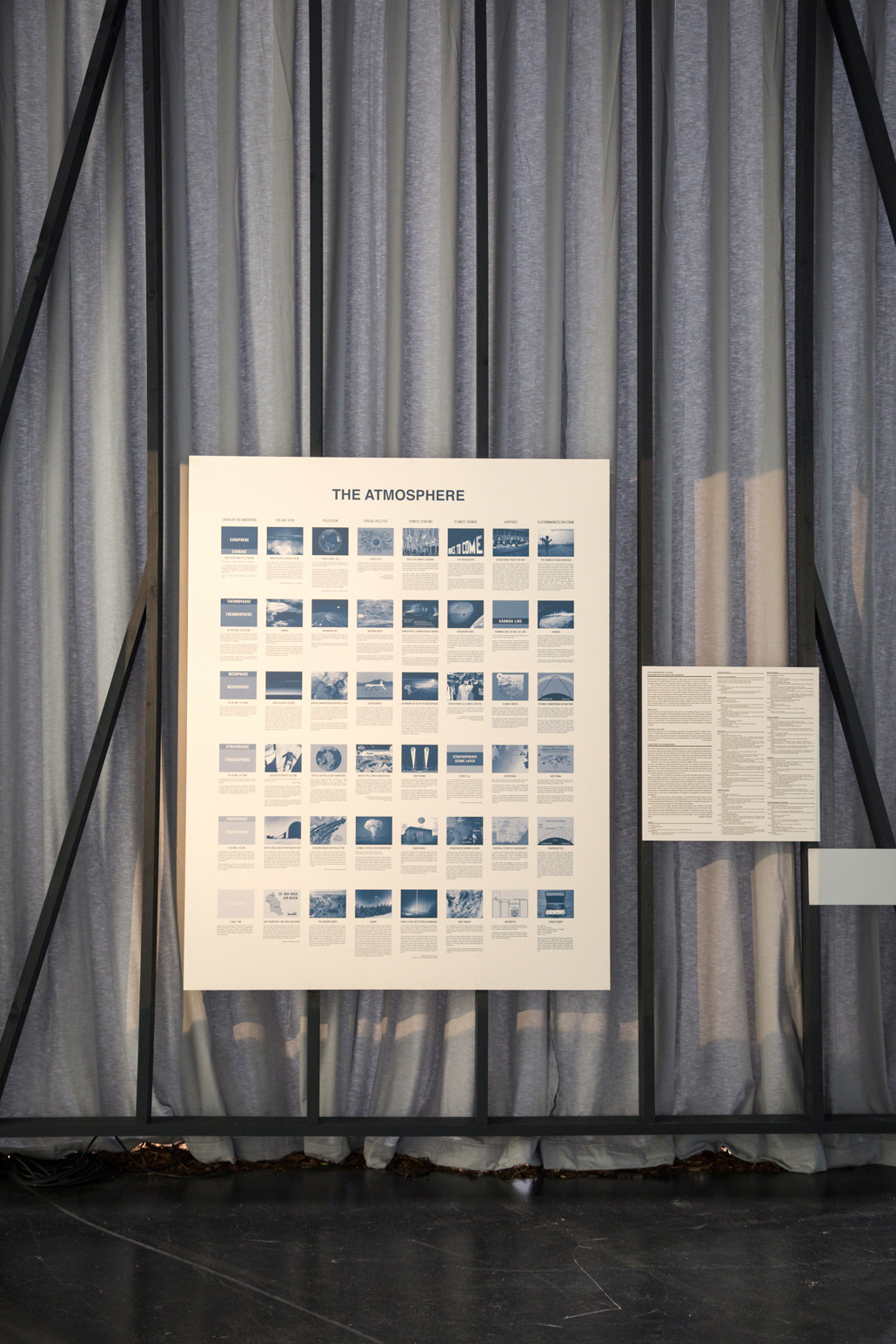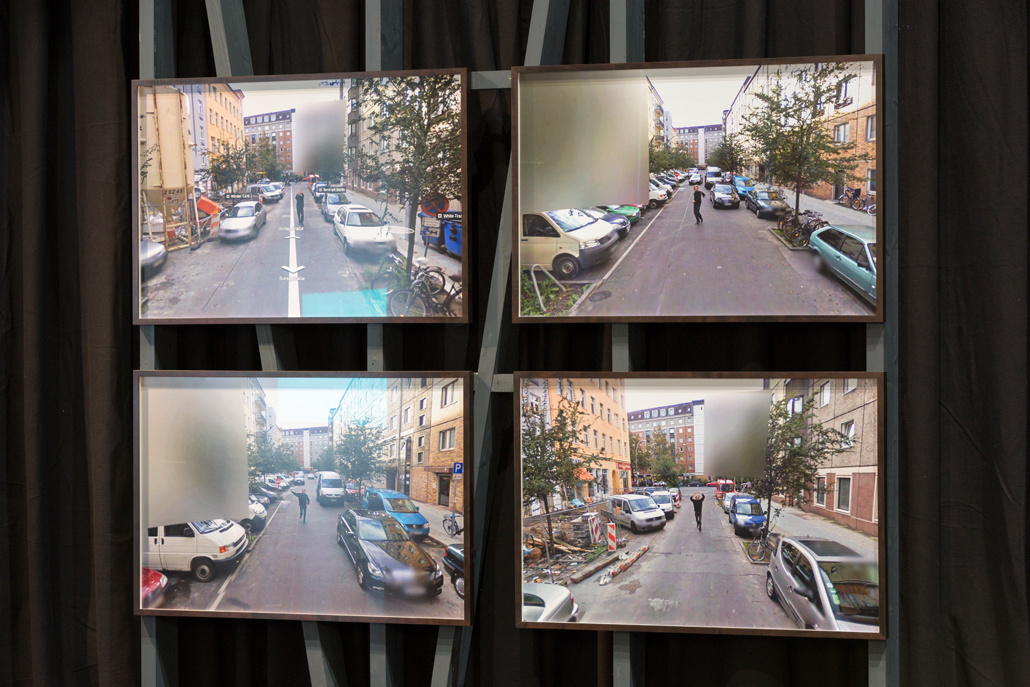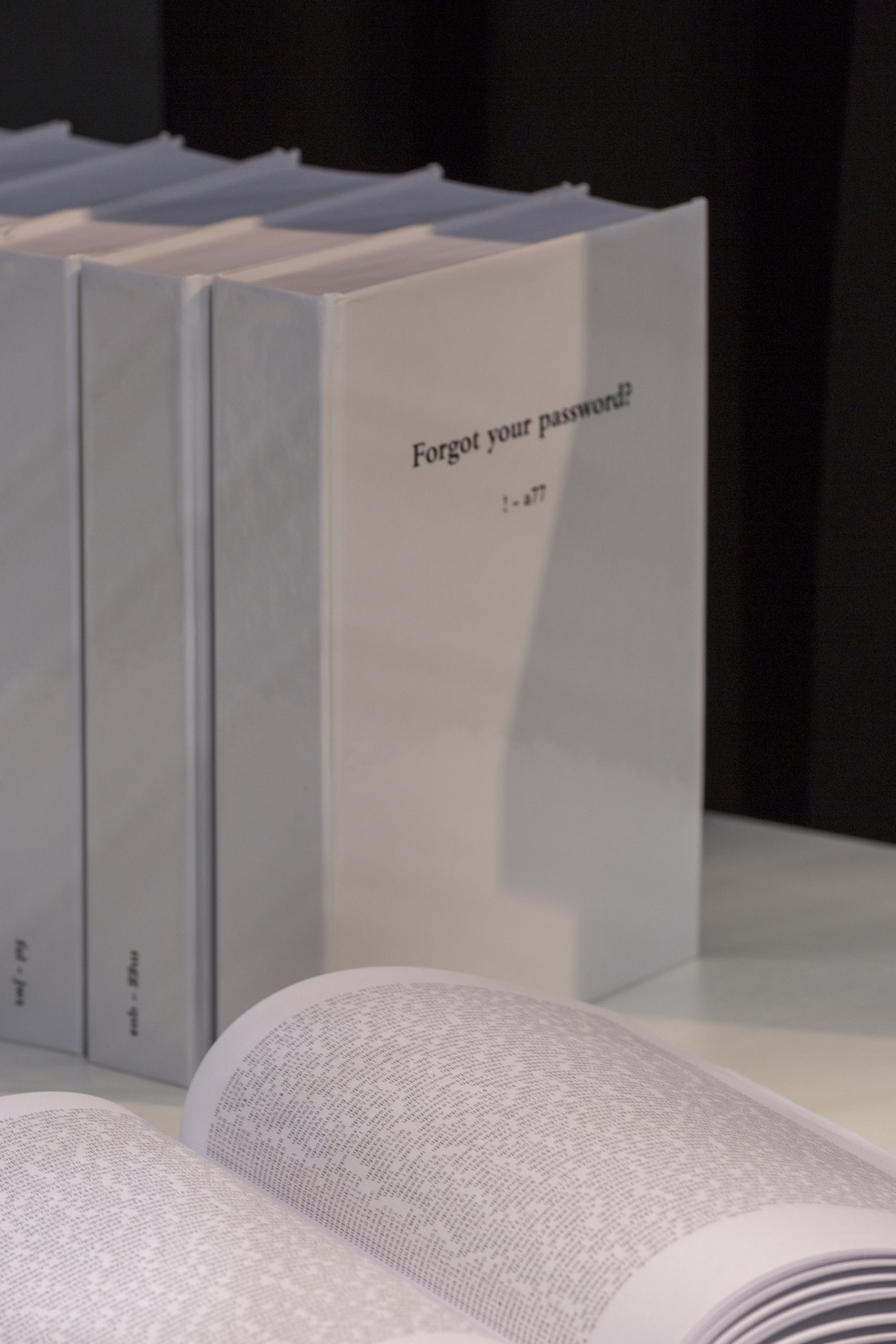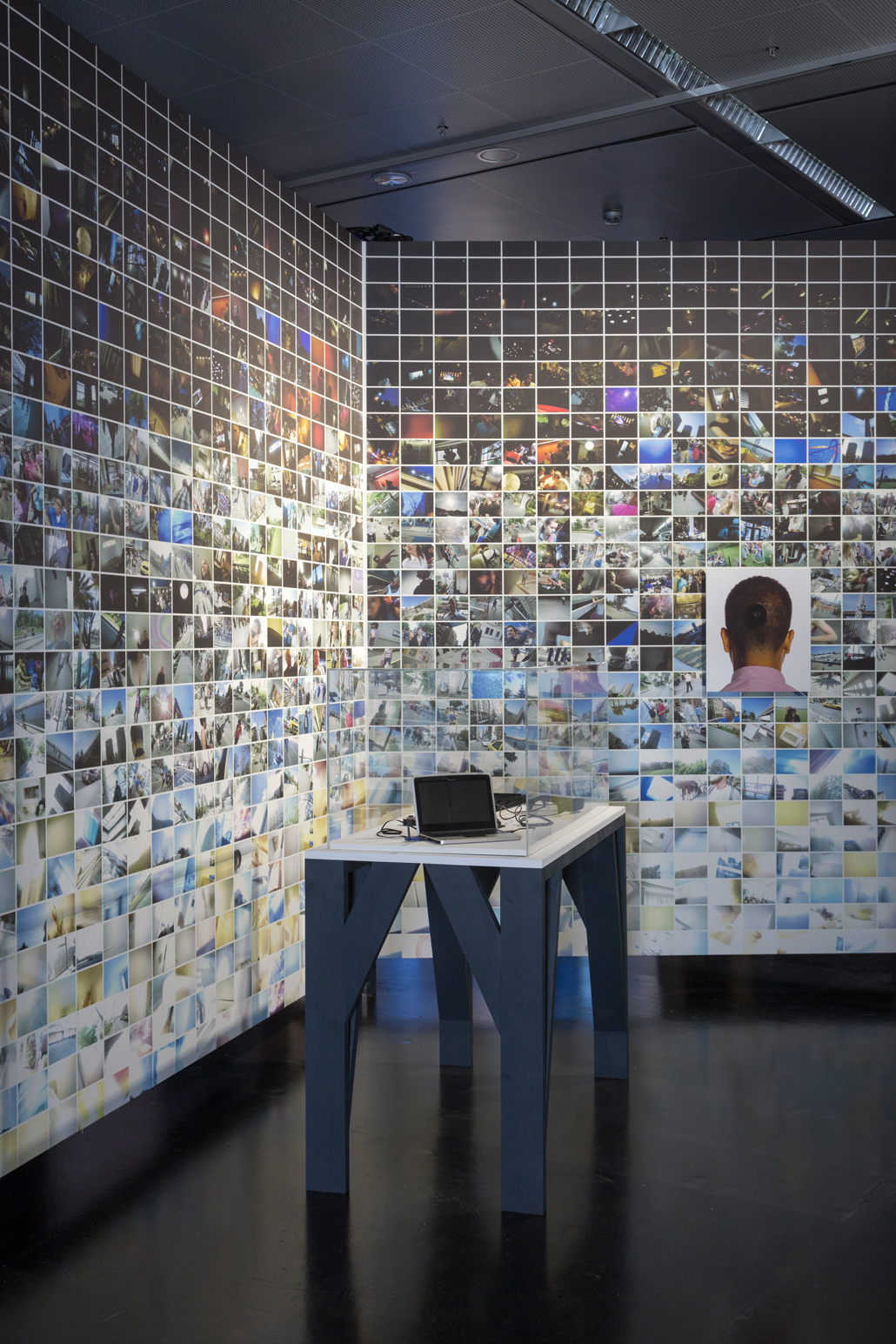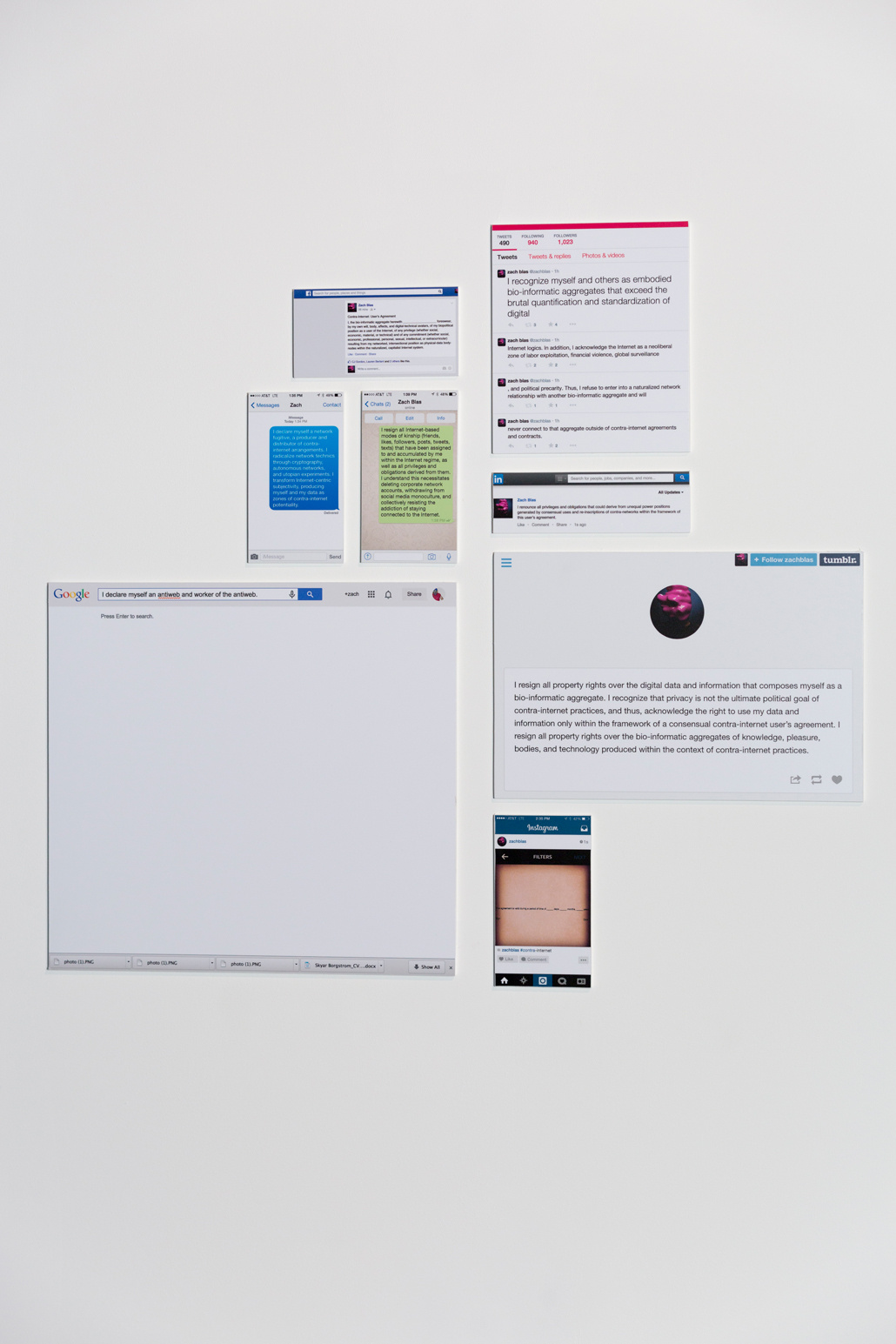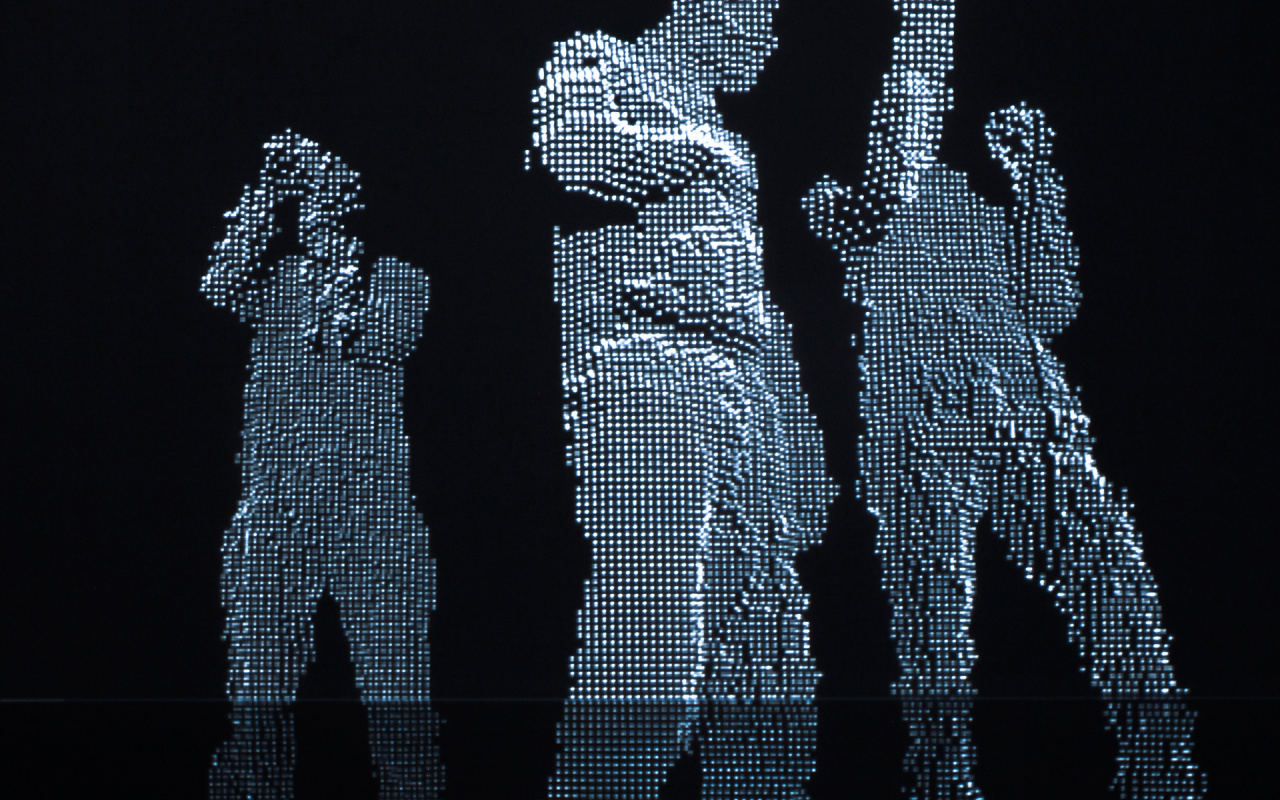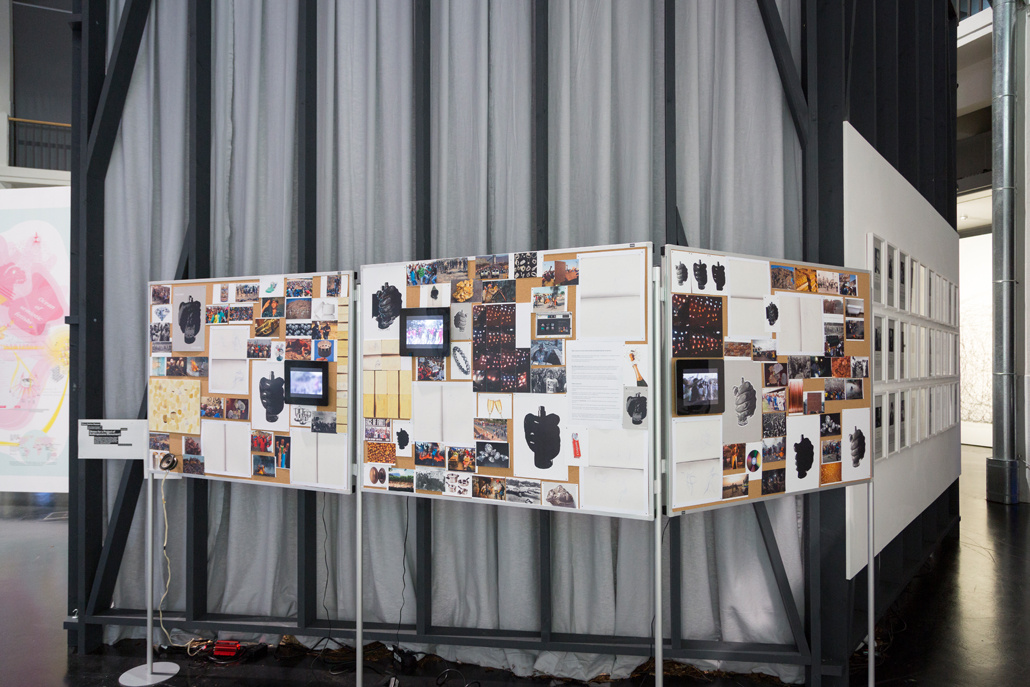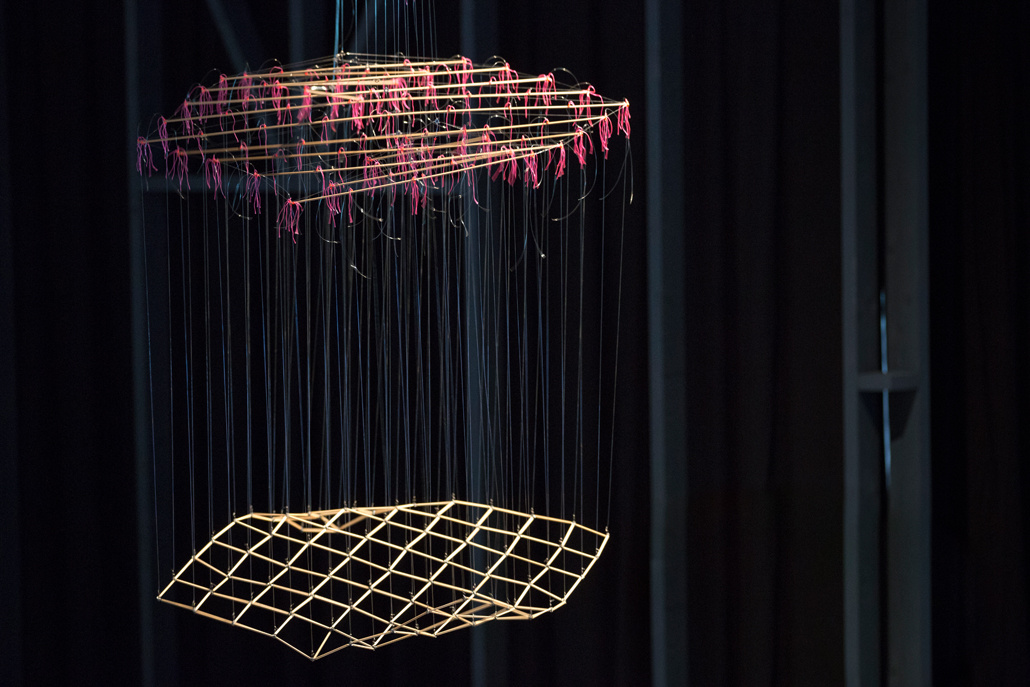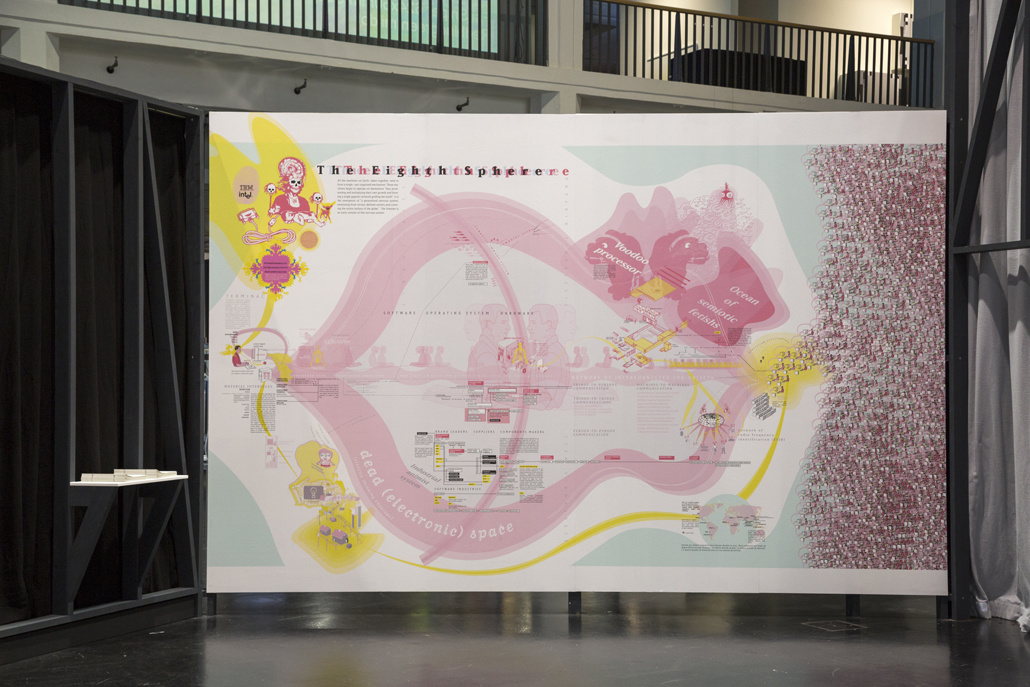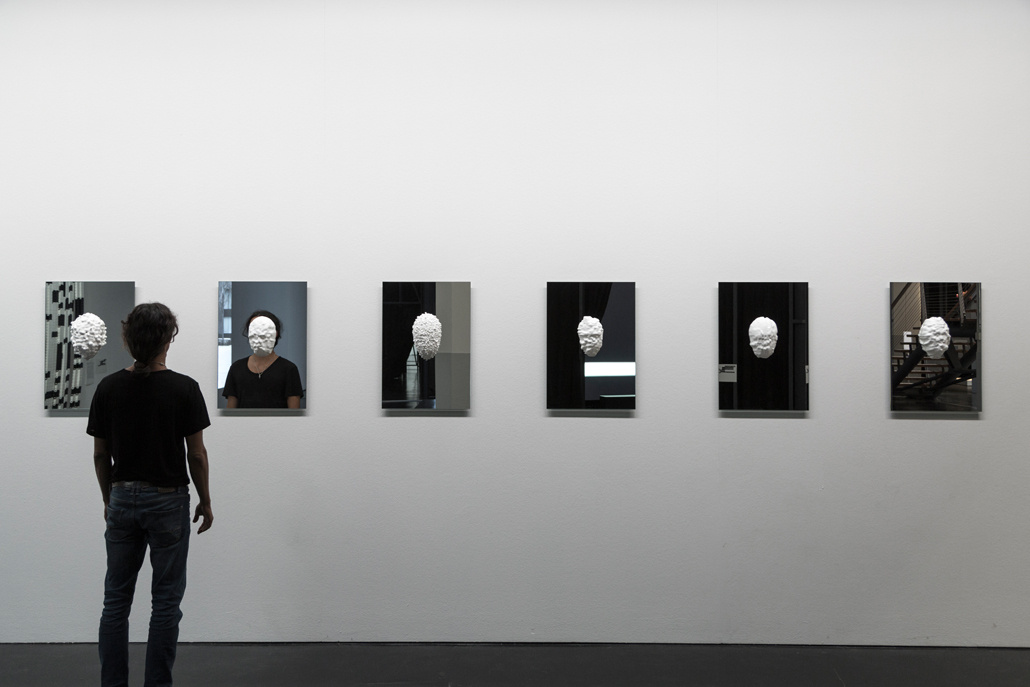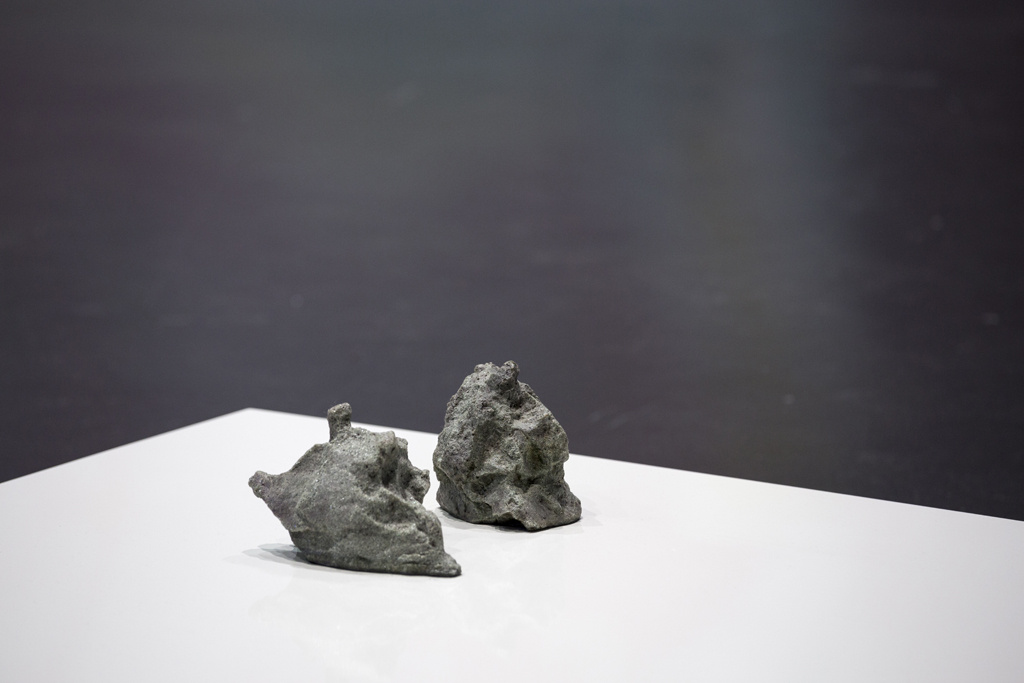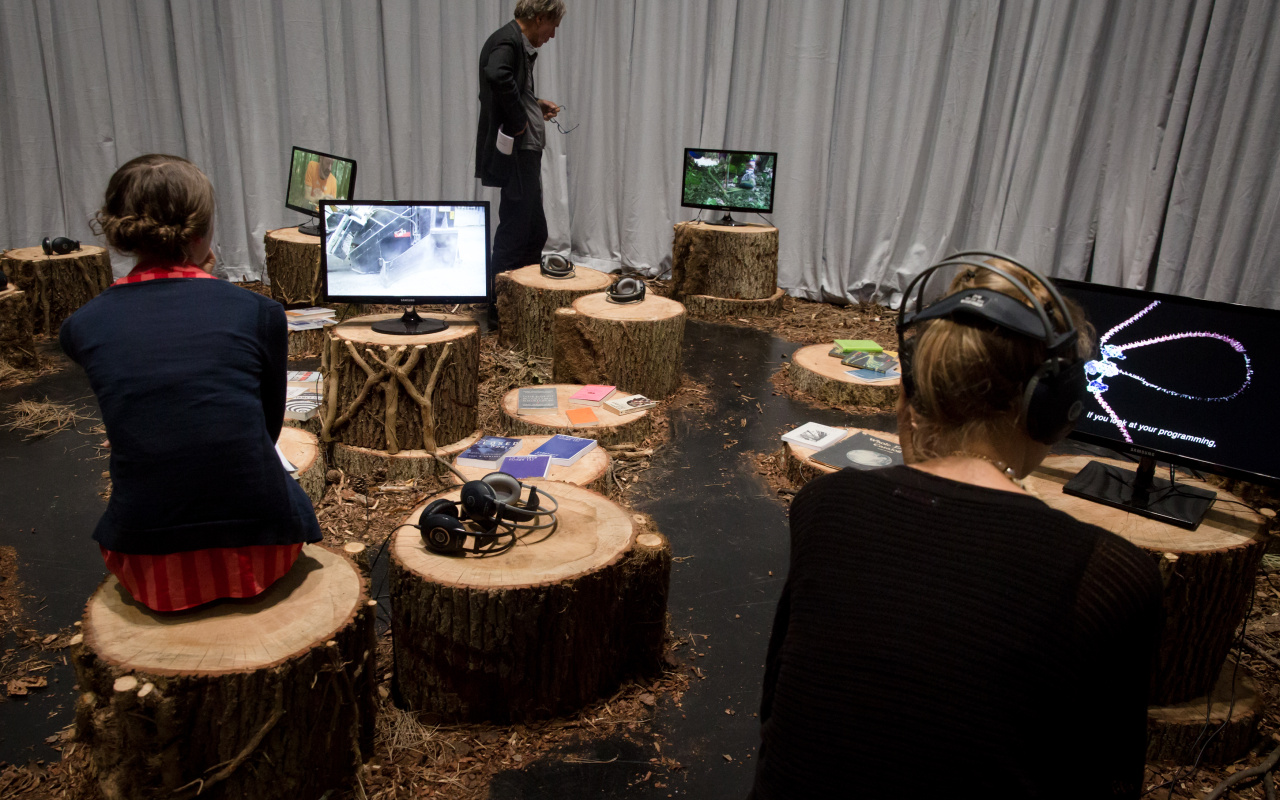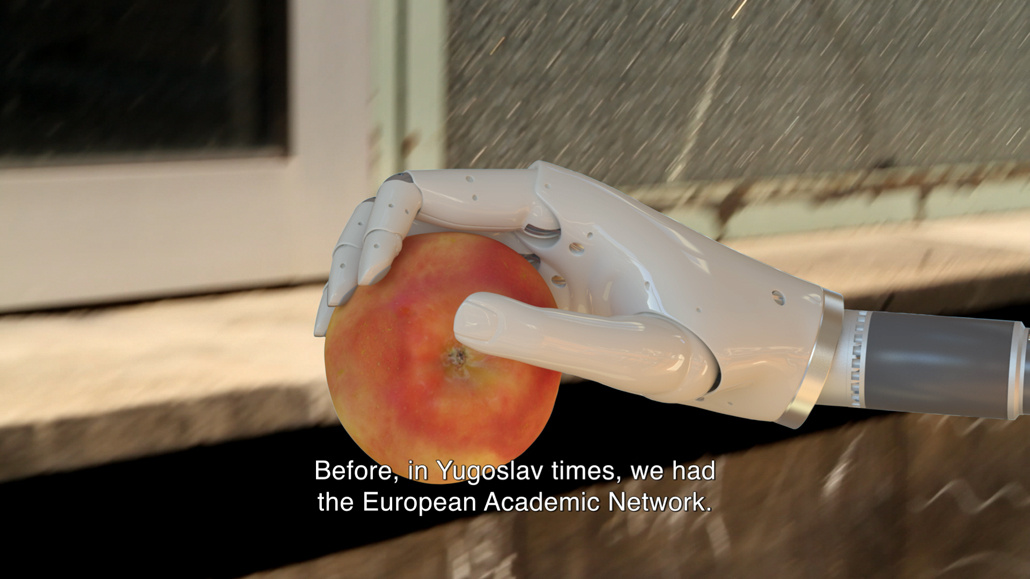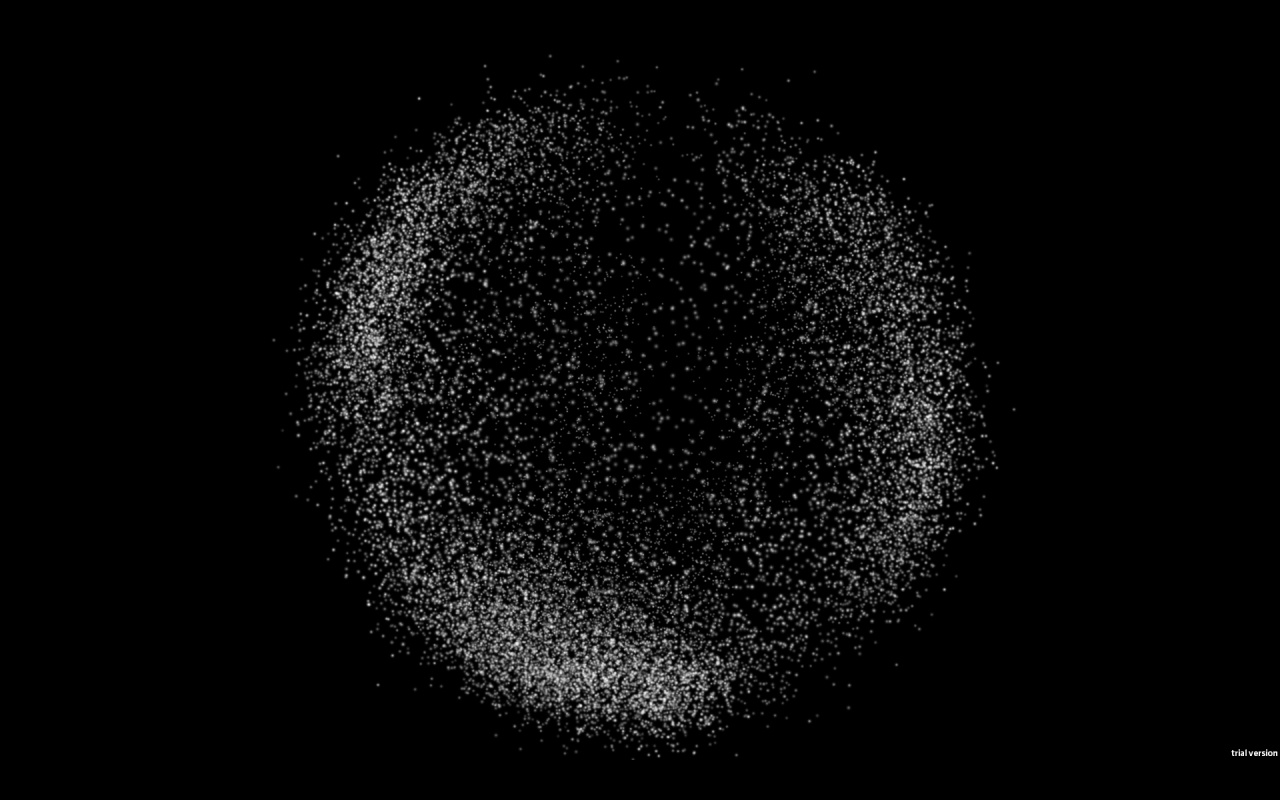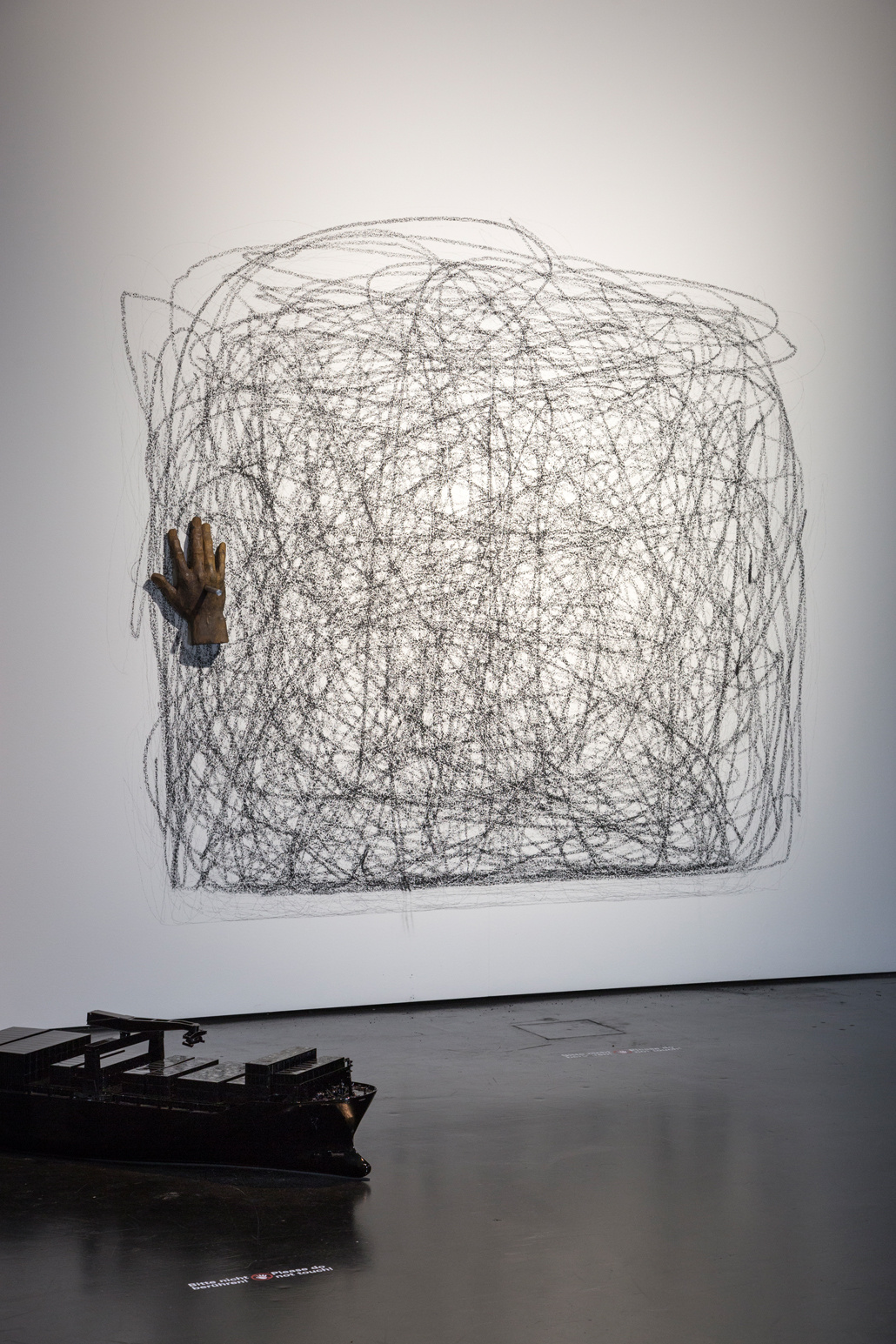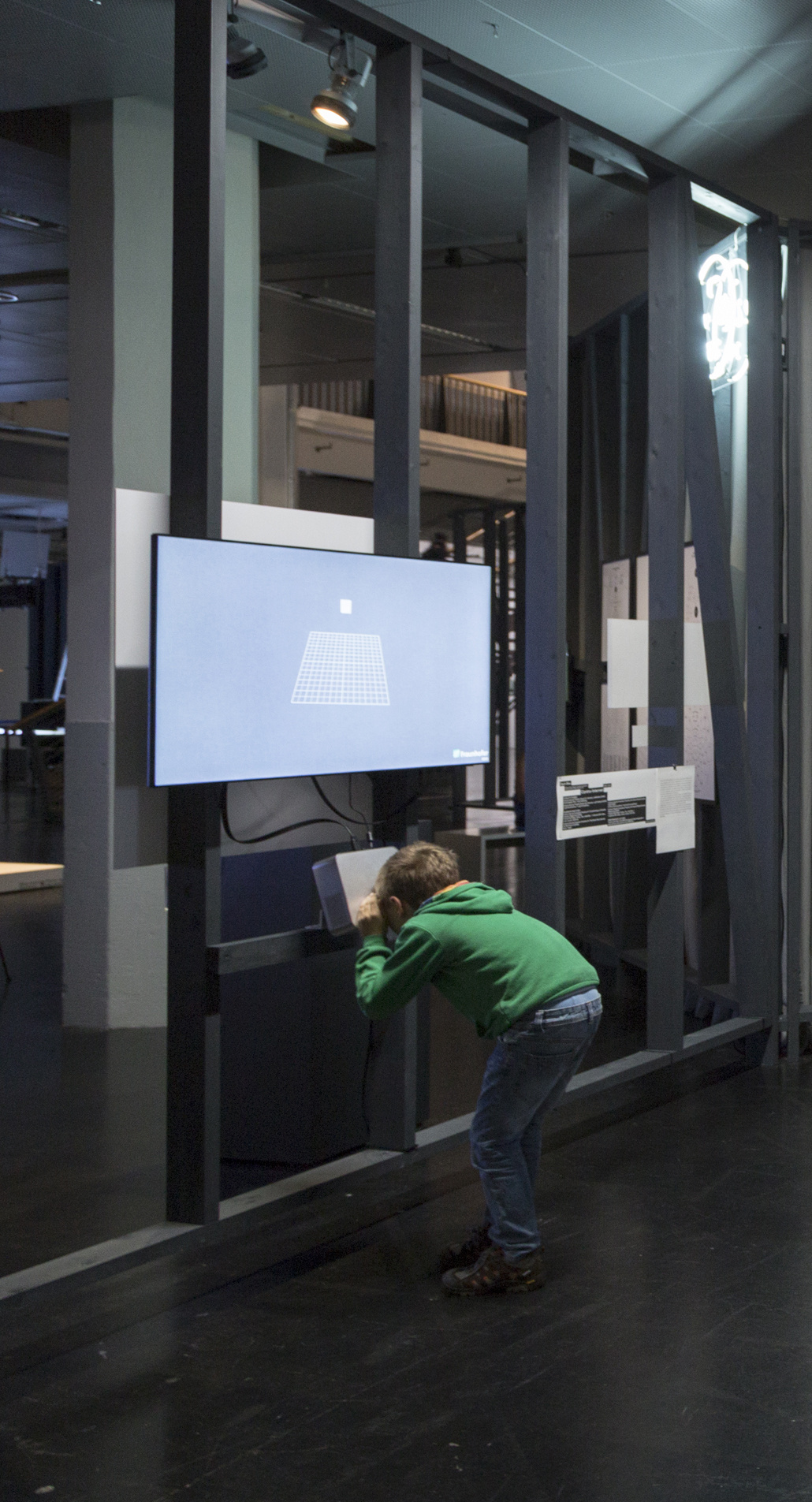Works of the Artists A–F
Infosphere
ATimo Arnall, Jack Schulze,Einar Sneve Martinussen »Immaterials: The Ghost in the Field« | BAmy Balkin»The Atmosphere: A Guide« Aram Bartholl »15 Seconds of Fame« & »Forgot Your Password?« Wafaa Bilal »3rdi« Zach Blas »Contra-Internet« Blast Theory »Karen« Bonjour, interactive lab »Passage« Natalie Bookchin »Zorns Lemma 2« Dineo Seshee Bopape »(Notes on a Project of the Monument for the Anthropocene)« David Bowen »tele-presenter water« James Bridle »The New Aesthetic« Bureau d’Études »The 8th Sphere« |
CEmma Charles»Fragments on Machines« Tyler Coburn »Waste Management« Sterling Crispin »Data Masks« | DStéphane Degoutin & Gwenola Wagon»World Brain« Dennis Del Favero »Vogesen« Aleksandra Domanović »From yu to me« |
EExpanded Sense Organs:Collection of Wearables | FThomas Feuerstein»Manifesto« Fraunhofer IOSB »Sensorbox« |
_____________________________________________________________________
Timo Arnall, Jack Schulze, Einar Sneve, Martinussen
Immaterials: The Ghost in the Field (2009)
The photographs of Timo Arnall, Jack Schulze and Einar Sneve Martinussen, taken with long exposure times and combined with stop-motion animations, serve to visualize otherwise invisible radio fields of so-called RFID tags, i.e. transponders for transmitting and receiving electromagnetic waves. In their video, the artists present various experiments and introduce the recipients to a previously unknown and invisible world, showing the energy pulsating through their devices in a room. However, the visualized area should not be confused with the radio field itself; rather, it shows the limits of the space within such a field in which an RFID transponder and an RFID reader can interact with each other. The shape of the field changes according to the alignment of the reader and transponder. This creates striking imaginary structures that are visualized with the aid of LEDs in different colors.
_____________________________________________________________
Amy Balkin
The Atmosphere: A Guide 2013/2015
»The Atmosphere: A Guide« (2013/2015) is an essay in poster form, a travel guide through the atmosphere that depicts human influences on the sky: from pollution to spatial politics to climate change and the electromagnetic spectrum. The work of the artist Amy Balkin allows the viewer to place the infosphere in the concrete reality of our world and our ecosystem. On its way through the layers of the atmosphere from normal zero to the outermost exosphere, the work deals with complex questions concerning atmospheric politics and its manifold influences of a chemical, narrative, spatial or even political nature. The travel guide refers visually and conceptually to so-called »Cloud Code Charts«, which are closely related to the cloud atlases commonly used in Germany: These are charts from the era before the satellites, which served as a visual aid to weather observers. The artist transformed this original model into a visual essay. What at first appears to be a pure report with data explained in case studies actually serves as a starting point for a reflection on the state of the atmosphere. The essay shows the encounter and the network of relationships of those factors that influence the actual as well as the possible conditions of our ecosystem – which in turn sharpen the spatial-ecological and political consciousness of the viewers.
_____________________________________________________________
Aram Bartholl
15 Seconds of Fame (2009)
While Aram Bartholl drank a coffee at Café MÖRDER in Berlin-Mitte on the morning of October 13, 2009 as usual, he suddenly recognized one of the Google Street View recording vehicles in a passing car. After Google began in the USA in 2007 to systematically photograph the streets of all cities and make them accessible online via the web service »Google Earth«, data protectionists in Germany had reacted with strong protest. Bartholl now took advantage of the opportunity to leave his coffee and run after the Google Street View car, which suddenly passed by, to be filmed. In a fifteen-second performance, Bartholl transformed the street view of Google Street View into his own work of art. More than a year later the pictures of the streets of Berlin-Mitte went online at Street View, since then Aram Bartholl's performance is immortalized. Bartholl's work ironically refers to a statement by Andy Warhol from 1968, according to which in the future every person will be world-famous for fifteen minutes at some point in his life. Warhol thus alluded to the ephemerality of media awareness: The time span of fifteen minutes is again undercut by Bartholl in »15 Seconds of Fame«.
_____________________________________________________________
Aram Bartholl
Forgot Your Password? (2013)
Millions of people in more than 200 countries use the online network LinkedIn, which primarily serves the maintenance of professional contacts. In summer 2012, this network was the victim of a hacker attack and lost its entire user database: all user names and passwords were stolen and appeared a few months later for everyone to access online on the net. In a kind of encyclopedia in eight volumes, Aram Bartholl compiled 4.7 million of these LinkedIn passwords in alphabetical order. To protect private data, only passwords are listed, not user names. Bartholl's work reflects the tension between public and private interest, between the protection of privacy on the one hand and the publication of data on the other. The eight volumes illustrate the amount of data available online today. At the interface of digital and real identity, exhibition visitors are invited to look up their own passwords.
_____________________________________________________________
Wafaa Bilal
3rdi (2010–2011)
In 2010 Wafaa Bilal had a digital camera implanted as a kind of third eye in the back of his own head. This camera took a photo every minute for an entire year and a USB cable permanently connected the digital camera to a laptop. The pictures were published directly on the artist's website. This one-year performance shows the artist's activities from the perspective of what literally happened behind his back. The photographs taken without the influence of a photographer, which were published without making a conscious selection, could be called »radically objective« or »innocent« in the sense of Roland Barthes. The potential of the images to tell stories has been greatly enhanced by online distribution: the viewers must themselves provide their own necessarily subjective interpretation of what is happening.
_____________________________________________________________
Zach Blas
Contra-Internet (2014–2015)
»Contra-Internet« deals with the increasing militancy and infiltration of the »Internet«, for example through the growing worldwide spread of autonomous mesh networks, encryption tactics and darknets. »Contra-Internet« aims to serve as a conceptual, practical and experimental framework for the rejection of the neoliberal logic of the »Internet« and at the same time to build alternative infrastructures. »Contra-Internet« consists of several series and firstly criticizes »the Internet« as a hegemonic term for digital networks and as the most important arena of political control. Second, it documents and speculates about those network alternatives that social movements and activists are currently developing worldwide. Inspired by »Manifesto contra sexual« (2002) by the theorist Paul (Beatriz) Preciado, »Contra-Internet« chooses a feminist-queer perspective in an effort to unite such political positions with a hacker ethic.
_____________________________________________________________
Blast Theory
Karen (2015)
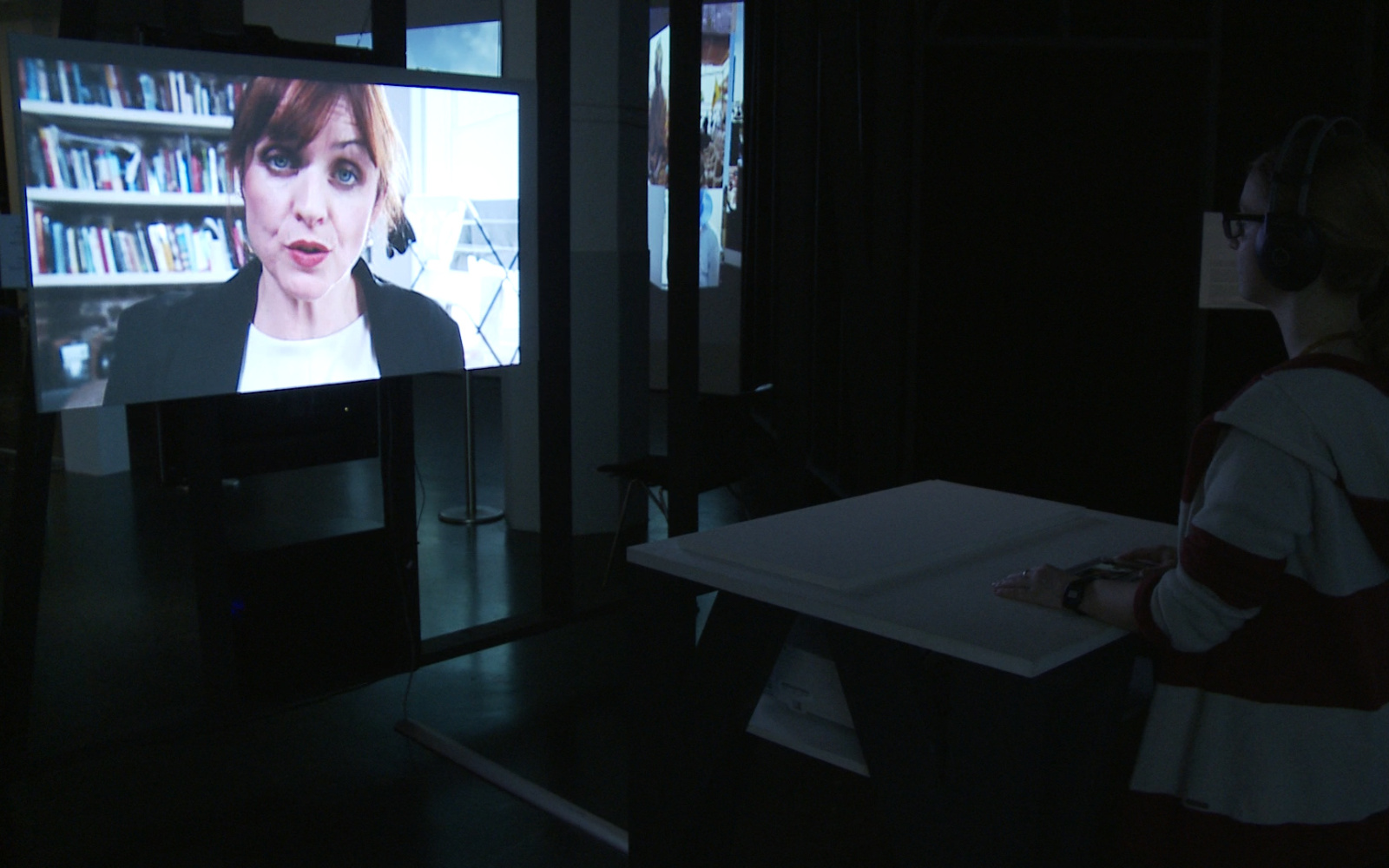
Blast Theory: Karen (2015)
Karen is an app for smartphones with which users come into contact with life coach »Karen« in a mixture of interactive film and computer game. At the beginning she asks for some personal details to get an idea and seems almost too friendly. The questions underlying the app and Karen's artificial intelligence come from hundreds of evaluated questionnaires used for psychological profiling. The software makes a psychological classification based on the user's answers and gives appropriate advice. The artistic overhaul of psychological profiling goes so far in narration that Karen becomes more and more curious and even reacts insulted if you don't call her back. She deliberately ignores personal boundaries, continues to invade the private sphere and seems to know things about the users that do not concern her. Blast Theory developed »Karen« against the background of the increasing relevance of Big Data. Large companies such as Facebook or Google and governments collect data from private individuals, which they also use to algorithmically determine and thus predict human behavior. At the end of the game experience, a personalized data sheet reveals the individual psychological profile so that you can also compare yourself with other players.
_____________________________________________________________
Bonjour, interactive lab
Passage (2013)
Data defines today's digital life and encompasses both our past and the present. When surfing the Internet, like tracks, Internet browsers record logs, the pages we visit are stored. Our course reflects our preferences, thoughts and feelings, creates a digital picture of us. Nevertheless, this picture is updated and overwritten with every new visit to the Internet. »Passage« is an installation that both visually illustrates our temporary data tracks and the resulting digital image and accentuates them with sounds. A digital scanner converts the viewer's body into a 3-D-pixel image that only lights up for seconds in a dark room and that quickly dissolves into its pixel components with an acoustic background. Similar to the tracks on the Internet, this 3-D pixel image is fed with information by every new visitor before it disintegrates and leaves an empty screen waiting for new data.
_____________________________________________________________
Natalie Bookchin
Zorns Lemma 2 (2007)
The remake of Hollis Frampton's structuralist film »Zorns Lemma« (1970) combines dozens of screenshots of security camera videos into a coherent work. It starts with images of letters that define the structure of the following images in alphabetical order. In each subsequent pass of the alphabet, one letter is replaced by a webcam image. This process is repeated until all letters of the alphabet have been replaced. Unlike the public space shots Frampton uses in »Zorns Lemma«, which were taken exclusively in the USA, Bookchin uses images from all over the world – she adds to the original concept of the work the preoccupation with the subject of surveillance in a globalized world.
_____________________________________________________________
Dineo Seshee Bopape
Notes on a Project of the Monument for the Anthropocene (2014/2015)
The work of Dineo Seshee Bopape makes us aware that contemporary media culture is only possible through geological resources. The materiality of the infosphere begins underground, with minerals, precious and heavy metals, which are necessary for the production of computers, tablets or smartphones. The geography of the extraction of these raw materials, which are mostly mined in China, the Congo, Brazil, Russia and South Africa, reflects the neo-colonial logic behind the technology. Bopape is dedicated to the geopolitical aspects of the media in South Africa. In her work, the artist combines the images of gold, platinum, copper and their by-products found on the Internet with images of the miners – the underground proletariat. The high price for the technical progress of the West is paid by the miners. The extraction of metals very often takes place under inhuman working conditions without safety measures or protective clothing. It is also associated with the resettlement of thousands of people, causing human suffering and often serious environmental damage. How much people suffer from working conditions is demonstrated by an incident that took place in the South African Nkaneng settlement in 2012, when 34 miners peacefully demonstrating for a living wage were brutally shot by the police.
_____________________________________________________________
David Bowen
tele-present water (2011)
The movable grid structure designed by David Bowen is controlled by a sophisticated mechanism mounted on the ceiling of the exhibition space. The wave-like movement accurately reflects the swell in the middle of the Pacific: A buoy sends data on the water level and intensity of the movements to the National Oceanic and Atmospheric Administration in the USA. Bowen uses this data for his project, the swell is scaled to the size of the room installation, but otherwise remains unchanged. However, the access to detailed information about a distant location demonstrates the detail of our knowledge: the exact geographical position of the buoy is unknown since it drifted from its starting point. The relevance of tele-present water is therefore to make clear to the viewer that the infosphere is full of holes and that our knowledge is detailed but always particulate.
_____________________________________________________________
James Bridle
The New Aesthetic (6. Mai 2011 – ongoing)
It all began on May 6, 2011 with a post under the title »The New Aesthetic«. In this article James Bridle presented pictures and links that he had collected over the years and which he now compiled in a blog for the first time. The first posts like »Guardian gallery of agricultural landscapes from space«, »Tracking iPhone locations« or »CV Dazzle (Camouflage from face detection)« already shed light on Bridle's intention: In a modern network culture, the act of selecting and organizing the disparate material available online represents a way of expressing personal views on this material and a critical attitude towards »the politics and politicization of networked technologies«, as Bridle himself puts it. For him, the term »new aesthetics« is not about beauty. Rather, it serves to explore the visual content of the web and the numerous heterogeneous realities that are reflected in it. Thus the web reveals its potential as an access aid to overlapping realities and as an instrument for knowledge production.
_____________________________________________________________
Bureau d’Études
The 8th Sphere (2010)
Bureau d'Études is a conceptually working group of artists mainly concerned with the medium of the map. Thus, the artists map the power, ownership and interest relationships in politics, the economy and the social sphere at global and local levels. The ruling symbolic order is thereby revealed. With »The 8th Sphere« they examine the communication channels and power relations in the world of cognitive capitalism, which is shaped by the knowledge society and the dominance of computer technology. The entirety of all machines in the world corresponds to the »general intellect« formulated by Karl Marx, a gigantic network spanning the earth, which is composed of synapses like a nervous system. The production of knowledge in this socio-technical system is only made possible by the transmission of information by means of electromagnetic waves, software and hardware production. Technology creates a structure of abstract dominance that determines the social and biopolitical order. Does the thematized transition from organic to technical intellect, from human to machine, appear to be a prognosis of a dystopian future or does the Bureau d'Études only record the status quo?
_____________________________________________________________
Emma Charles
Fragments on Machines (2013)
The title of the video refers to the so-called »machine fragment« from Karl Marx's Critique of Political Economy (1857/1858), in which the material and immaterial are linked to human work and abstract dominance is outlined by knowledge. The artist is interested in the Art Deco style skyscrapers in New York's financial district, whose architecture is today read as a symbol of 19th and early 20th century capitalism. These buildings now house the infrastructure for the Internet: Server, mainframe, kilometers of fiber optic cable. In her video, Emma Charles immerses herself in the heart of post-industrial financial capitalism. There is a reason for the proximity between server rooms and companies and banks engaged in high-frequency trading: the closer these companies are to the Internet infrastructure, the faster their algorithms reach their destination. In the three chapters of the video, Metropolis, Servers and Flood, one moves from the inside of this structure to the outside, into the city and further into nature, which in its unpredictability always threatens both technology and machines.
_____________________________________________________________
Sterling Crispin
Data Masks (2013–today)
Sterling Crispin's masks are based on biometric face recognition software, in which algorithms use geometric arrangement and surface texture to identify a human face in frontal view. Crispin, however, follows the reverse path of re-visualizing the visualized: What seems to us to be a pixelated, inhuman ghost mask is what a computer thinks is a human face. These shadows of a face are eerie portraits, which, however, do not depict a particular person, but rather show how machines perceive people, reduce them to general recognition features and thereby abstract them from their actual appearance. Crispin deals with what constitutes human existence and investigates the boundaries between individuality and general recognizability. At the same time, his masks also shed light on the invisible processes of surveillance mechanisms and raise the question of how humanity is perceived, perhaps even changed, and to what extent man and machine interact. Crispin is not concerned with condemning facial recognition, but rather with making its structures transparent.
_____________________________________________________________
Tyler Coburn
Waste Management (2013–2015)
»Waste Management« deals with the global problem of e-waste by dealing with the work of a specific Taiwanese recycling company. The country is famous for producing more electronics per capita than any other nation on earth. It is therefore hardly surprising that Taiwan is at the forefront of efforts to develop technologies for processing e-waste. Materials obtained through recycling include bricks, gold-potassium cyanite, precious metals and even art. Waste Management therefore takes the form of an installation of »found works of art«: two cast stones consisting of glass from CRT monitors and glass fibre powder from printed circuit boards. These objects are accompanied by two stories: One tells in English about the circulation and final transformation of a picture tube into this stone work of art; the other recites in Chinese Joseph Addison's story »The Adventures of a Shilling« (1710)[The Adventures of a Shilling], which ends with an artist melting the protagonist into one of his works. Both stories come from the genre of »it narratives«, a sub-genre of 18th century British literature in which money or goods tell of their circulation through the then emerging global economy.
_____________________________________________________________
Stéphane Degoutin & Gwenola Wagon
World Brain (2015)
»World Brain« is an Internet project and a non-linear essay film that takes viewers on a journey through the existing architecture of the infosphere and Internet folklore. The documentary strand of the film is based on found footage: Youtube videos, interviews, pseudo-scientific and scientific reports, company trailers etc., which reveal the physical and virtual infrastructure of the Internet – data centers, satellites, submarine cables, logistics, principles of high-frequency trading, knowledge distribution – on which cognitive capitalism is based. The narrative strand examines utopias that have predicted the collective intellect for centuries: animal magnetism and galvanism, ether, the networking of nature, the noosphere, the connection of humanity to a common network. Some of these partly esoteric theories were part of the counterculture of the 1960s and early cybernetic society. The Internet can be interpreted as a first realization of such a collective nervous system or network. Unexpectedly, a group of scientists try to survive in the forest using Wikipedia and The Whole Earth catalogues, Internet kittens, the shark that nibbles on a submarine cable, telepathic rats, DIY devices and much more combine to form a structure that forms the »World Brain«.
_____________________________________________________________
Aleksandra Domanović
From yu to me (2013–2014)
In »From yu to me«, Aleksandra Domanović examines the history of the Internet in Yugoslavia with the help of interviews, archive and television material. This reflects the historical upheavals the country got into after 1989: Shortly after the introduction of the top-level domain .yu, the country began to disintegrate. The domain .yu evolved from several domains of independent states, until .yu finally became history itself and ended up in the museum. The film focuses on two computer scientists who administered the domain at different times: Borka Jerman-Blažič and Mirjana Tasić. Their narration reveals the hidden side of the network – its material nature and dependence on the work of concrete people who, apart from bureaucracy and wars, maintained the function of the network. As an eerie sign of this human-machine relationship, the so-called »Belgrade Hand« (a robot hand developed at the University of Belgrade in the 1960s) is displayed several times during the film as archive material and as computer-generated animation.
_____________________________________________________________
Expanded Sense Organs
Collection of Wearables
Sigmund Freud described man as a weak creature: Only through cultural achievements could he free himself from nature and compensate his not perfect abilities with tools and media. Wearables (the term derives from Wearable Computing) such as data glasses, smart watches, activity trackers, brooches, implants or electronic clothing will soon be worn by us completely naturally and can be seen in the context of the prosthesis theory developed by Freud and Marshall McLuhan, which regards the media as extensions of man (McLuhan, »Understanding Media: The Extensions of Man«, 1964). The person of today is a motor and sensory extended person. Thanks to technology, it is now possible to miniaturize devices that can help you without first interacting with an interface. At the same time, the new technology raises questions about privacy and data protection. Do wearables and the data they collect belong to the owner, manufacturer, carrier or cloud?
_____________________________________________________________
Dennis Del Favero mit Elwira Titan, Peter Weibel
Vogesen (2015)
Instead of continuing to perceive the atmosphere as a natural spectacle separate from humans, »Vogesen« emphasises the reciprocal influences in the climate cycle. In the age of the Anthropocene, artists and theorists in particular must engage in a multi-layered conceptualization of this relationship between man and his environment in order to adequately grasp and aesthetically implement the obvious upheavals. The terms atmosphere, biosphere and infosphere merge – the global weather, the immediate environment and the networked knowledge community fertilize and manipulate each other, overlap and are dependent on and influenceable in every respect. The exemplary project »Vogesen« visualises the complex interactions on the basis of never seen satellite images, which have recorded the cloud formation of the earth over two whole years and can be explored by the visitors via intuitive control.
_____________________________________________________________
Thomas Feuerstein
Manifesto (2009)
A larger-than-life hand carved in stone moves magically across a wall leaving a trace of charcoal. The exact shape of this infinite line is derived from the trade data of major reinsurers such as »Lloyd's of London«, which are transmitted to the hand by a computer server in the form of a container ship. In contrast to the usual presentation of bull and bear tables, however, these data are subject to a new topology. The events on the market constantly create new overwrites that become thicker and thicker and manifest themselves as dark clouds: Networked systems and global capital flows are becoming meteorological categories that transform the economy into a weather forecast of our civilization. The hand naturally provokes associations with Adam Smith's invisible hand, but that hand seems to be cut off, amputated by body and brain, and it is guided by something more like an occult tablet evoking higher powers. The container ship (DAIMONIA) functions as a server, but is also an allegory of the distribution of goods and wealth as well as an angel of fate, a messenger or demon of the economy. Where in ancient Greece the daimon was regarded as a guide and distributor of fate, today the economy determines our fate when it assigns and distributes goods, resources, energy and information. Since fate is a risky variable, it has always required appropriate handling, regardless of whether ritual sacrifices, risk diversification funds or insurance companies are used. The idea of insurance as a collective assumption of risk represents a secularization of magic and belief in capitalism; the name Lloyd's brings to the fore a historical depth, because this company insured expeditions to the colonies in the past. In accordance with his artistic method of »concept narration,« Thomas Feuerstein hangs large-format drawings and posters that ironically combine the economic and systemic with the surrealistic of Écriture automatique or the legendary of Acheiropoieton, a work of art that was not created by human hands. Economy and capitalism, faith and fate, cybernetics and class struggle make surprising connections and become a spatial history with different hands: The hand (lat. manus) becomes a manifesto.
_____________________________________________________________
Fraunhofer IOSB (Fraunhofer Institut für Optronik, Systemtechnik und Bildauswertung IOSB) Karlsruhe
Sensorbox (2015)
Fraunhofer is the largest research organization for application-oriented, future-oriented research in Europe. The Fraunhofer IOSB conducts special research and develops solutions in a wide variety of fields, ranging from grid integration of electric vehicles to research projects in industry 4.0 and safety at sea. With the advent of information technology in all areas of life, the interfaces for interaction between users and computers are playing an ever-increasing role. The »Sensorbox« displays the current scientific and technical status of camera-based human-machine interaction. Visitors to the exhibition are captured by a camera and the information collected is visualised in a technical presentation. Tracking of persons, analysis of posture, gesture recognition as well as recognition of head rotation and attention belong to the spectrum of possibilities of the »sensor box«. The unique feature of this technology is its ability to form a distributed installation so that larger areas could be covered by multiple sensor boxes. The fields of application of the »Sensorbox« can be used as examples to point out challenges that technologies and science present us with: The »sensor box« could be used in the areas of consumer research, security and monitoring, for example. The dilemma of »good« or »bad« application cannot simply be solved, but must first be discussed and negotiated in society.

